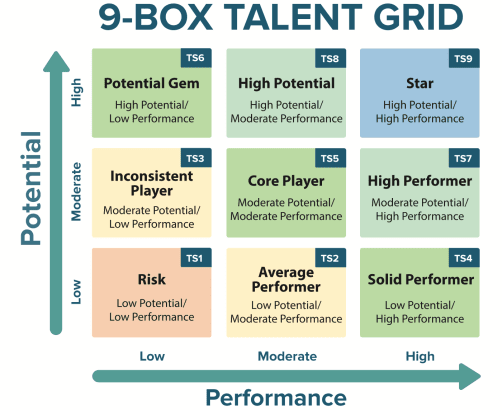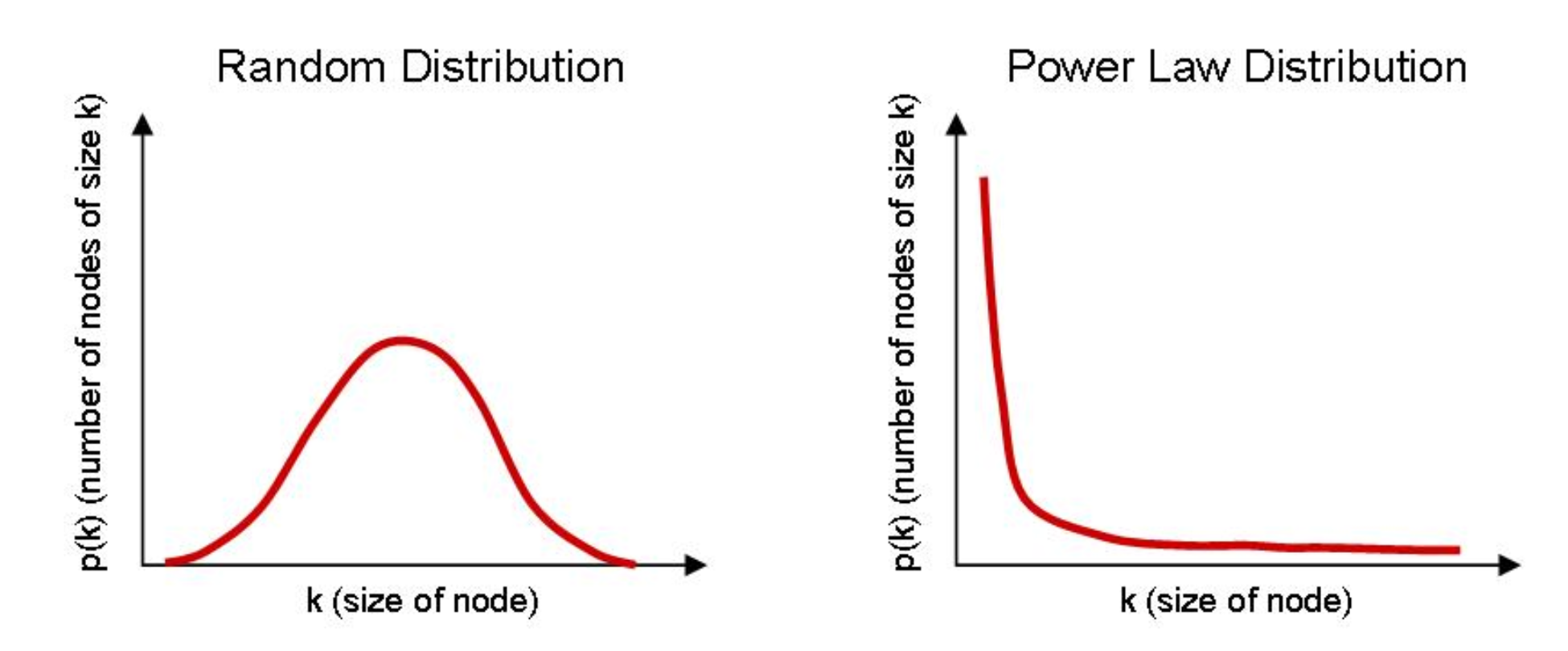Does your company use the nine-box talent grid? It’s a core model beloved by HR Departments around the world. You can tell how prolific it is from the number of Google records you see when you search for it – more than 13 million! And you know what? It makes my blood boil!
I hate it with a passion—even more than I hate annual appraisals (and that’s saying something). When a new client tells me they use it, I inwardly moan. It’s total garbage. Worse than that, it’s a model for mediocrity that has the potential to stunt your growth.
What is the nine-box talent management grid?

9-Box Talent grid
The nine-box grid is a talent assessment tool that divides and plots employees across nine key data points. It’s meant to evaluate employees’ current performance levels and potential for growth to fit them into these nine segments. On one axis, you have potential, and on the other, performance.
The issue I have is around the whole area of ‘potential’. Managers have to work out how these employees will change over time. How will the manager know? What are they measuring? It’s just guesswork. The grid also aims to predict employees’ future potential.
To be a ‘star’ performer on this chart, you must have high potential and performance. If someone is ranked as a poor performer but is felt to have ‘potential’, the manager should invest time, energy and resources into training them. It’s like fervently believing that Blackpool Beach donkeys will win the National. It’s just not going to happen. Don’t waste your resources on poor performers.
The nine-box grid is a tool used in performance management strategies.
The Bell Curve Versus Power Law
The nine-box grid presumes that talent is equally distributed on a bell curve. This may be true of staff that work on production lines. If you were the best at putting widgets in a box or screwing wheels on a car, you’d only be 2x better than average. But when it comes to cognitive performance, it’s a different ball game.

Clear performance expectations are crucial for identifying high performers. Instead of cognitive talent being equally distributed across a bell curve, it’s better represented by a Power Law. McKinsey demonstrated this beautifully in a ten-year study of executive performance. They found that high-performing executives in a flow state could easily be five times more productive than colleagues who were never in flow.
A-Players versus B-Players
I’ve sat down with hundreds of CEOs as a business growth coach. When I ask them to tell me the productivity gains from an A-Player versus a B-Player, they typically say between 5x and 10x. Then I ask whether they’re paying these star performers more. The answer? Almost always, ‘No’. Some are even paying these people less. This is madness.
Your focus must be on getting more of these A-Players into the business. They reduce management overhead, deliver outstanding customer service, write great code, make a disproportionate number of sales and consistently surprise and delight. To achieve this, you need to identify employees who are A-Players. But the nine-box grid doesn’t allow for increasing the number of A-Players. Instead, it focuses on having more ‘core employees’ – average B-Players that will bumble along and never set the world on fire. At this point, I want to kill myself!
A-Players are often the future leaders of the organisation.
Outdated Approach
The 9-box grid is a relic from the 1970s, a time when the business landscape was vastly different. Back then, the workforce was more static, and the pace of change was slower. Today, we live in a world where agility and adaptability are critical. The rigid structure of the 9-box grid simply can’t keep up with the complexities of modern talent management. It pigeonholes employees into narrow categories based on past performance and potential, ignoring the critical need for continuous learning and development. In a fast-paced business environment, where skills and roles constantly evolve, clinging to such an outdated approach can hinder your company’s growth and innovation.
Subjective Opinions and Bias
One of the most glaring flaws of the 9-box grid is its reliance on subjective opinions and inherent biases. When managers and HR professionals bring their personal biases into the evaluation process, it can lead to skewed and unfair assessments of employee performance and potential. This not only undermines the credibility of the talent management process but also risks alienating valuable employees. Imagine a high performer being unfairly labelled as having low potential due to a manager’s unconscious bias. To build a fair and effective talent management strategy, it’s crucial to use objective criteria and gather feedback from multiple sources, ensuring a more balanced and accurate evaluation of each employee’s performance.
Vague Labels and Limited Feedback
The 9-box grid’s use of vague labels like “high potential” or “low performer” does a disservice to employees. These broad categories fail to provide the specific, actionable feedback that employees need to improve and grow. It’s like telling someone they’re a “bad driver” without explaining whether they need to work on parallel parking or highway merging. The grid overlooks the complexity and nuance of individual performance by focusing on narrow boxes. Employees deserve detailed, constructive feedback highlighting their strengths and areas for improvement, enabling them to take concrete steps towards their development.
Tolerance of poor performance expectations

Here’s the main thing I object to about the nine-box grid. It enables poor performance to persist in your business. Managers are off the hook for their poor recruitment choices. Because they only exit people who are poor performers with no potential, they avoid tricky conversations with the people who the manager believes have ‘potential’.
Evaluating an employee’s performance is crucial for deciding whether to invest in their development.
So, you keep poor performers in your business and, worse than that, spend money on them! How does that make any sense? You don’t say, ‘Fred’s rubbish – I’m going to get rid of him.’ You say, ‘Fred’s rubbish, but I’m going to invest in him because it’s not Fred’s fault.’ How does Fred ever get out of your organisation? You’re going to be wasting time and money on him constantly. A performance improvement plan can be used to address poor performance, providing a structured opportunity for improvement.
My first job out of uni was in retail, working for M&S. We were taught about product positioning – the different points in the store where you’re guaranteed to sell more stuff. For us, it was the end of an island. Let me ask you. Do you put your best-selling product here because a 20% uplift in sales is worth way more money? Or do you put your worst product here, hoping it isn’t delisted? That’s what this is. You’ll waste your training budget on someone who doesn’t deserve development. Instead, you should target the A-Players that will help you achieve the growth you crave in your business.
Anchor talent assessment to behaviour rather than ‘potential.’
Rather than assessing ‘potential,’ we feel measuring behaviour is far better. Strategic talent management focuses on measurable behaviours. This is something tangible, something managers can point to in discussions. A good behavioural framework has the power to transform your business. It will codify your culture, clarifying the core values you want it to represent. You’re telling all your employees that they must be a behavioural fit and a high performer to stay in your company. They have to be making a cultural contribution.
Effective talent management strategies should be based on clear behavioural frameworks.
There are different ways to develop this framework, and it takes time. But it’s worth it. Once you have a behavioural framework, it can guide everything you do – hiring, firing, promoting and rewarding. It will also help you identify and manage any toxic or low-performing staff holding your business back.
Avoiding the promotion trap for future leaders
How many times have you come across poor managers? Plenty, I can imagine. I bet they got promoted because they were good at what they did. But they were lousy at management. We see this all the time.
Promoting the right individuals is crucial for maintaining effective senior leadership.
Exercises like the nine-box grid perpetuate it. This model says you may be a high performer in your job, but you’re not valuable to the organisation unless you have the ‘potential’ to be a leader. This is ridiculous!
An A-Player who’s great at their job is only amber on this grid. To be green, they have to be in line for promotion. Not all high performers need to be in line for future leadership roles. What is a ‘low potential/high performer’ anyway? Why would you even have that? You don’t need everyone to be a high-potential high-performer. You just need them to be a high performer.
Our client, Pax8, has sorted this by introducing a new remuneration structure. Their Client Account Managers have ten pay grades. You can be rewarded for your performance in this role without being a manager. Too often, the first developer in an organisation becomes a Dev Team Leader. And they’re useless at it. They have none of the requisite skills for leadership. So, using the nine-box grid has perpetuated this bollox of promotion being the only way to get on. It’s like using a hammer when you need a screwdriver!
Regular Feedback and Coaching
Effective talent management hinges on regular feedback and coaching, not just annual or bi-annual evaluations. The 9-box grid’s infrequent assessments can leave employees in the dark about their performance and development needs. To truly support and develop your team, providing ongoing feedback and coaching is essential. This means regular check-ins, performance reviews, and continuous learning and development opportunities. By maintaining an open line of communication and offering consistent support, organisations can help employees hone their skills, achieve their full potential, and drive the company’s success. Regular feedback isn’t just a nice to have; it’s a critical component of a thriving, high-performance culture.
Paying your high performers what they’re worth
Instead of focusing on what makes poor performers perform poorly, Google has taken the opposite approach. They reckon their engineers are 350x average—now that is an exponential difference. And they discovered that outstanding managers produce outstanding results. Instead of seeing these superstars as outliers whose skills can’t be replicated, they identified what they did differently and used these insights to improve the performance of other staff.
Effective succession planning involves recognizing and rewarding star performers. Lazlo Bock, former senior VP of people operations at Google, said, ‘In a misguided effort to be “fair”, many organisations underpay their best employees, producing the unfairness they are trying to avoid. And, more importantly, causing top talent turnover.’ Superstar employees are worth dramatically more than average staff.
Look at Netflix. They say they pay their people 125% of the market and get 5x more productive. So, they pay less for a given output than their competitors. They call this ‘delivering on talent density.’
A thorough talent review process helps identify and retain top talent.
Increasing the number of A-Players in your business is the quickest way to achieve the growth you crave. The nine-box grid is not the way to do this. Our clients have increased their percentage to 60 or even 70% A-Players, and the difference in their business is staggering. It’s like everyone’s in the SAS. They execute quickly, easily and efficiently, and their growth is exponential. Some of our newer clients have 10% A-Players at best. And progress is miserably slow.
Written by business coach and leadership coaching expert Dominic Monkhouse. Contact him to schedule a call here. You can order your free copy of his book, Mind Your F**king Business here.

